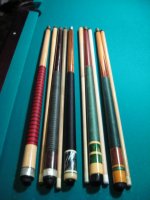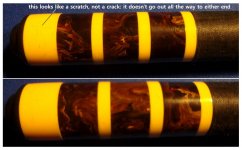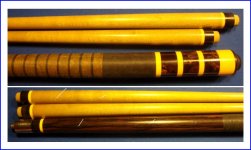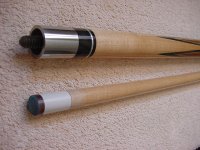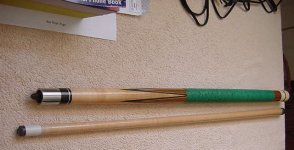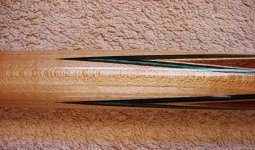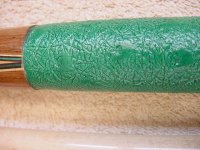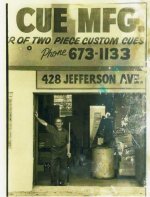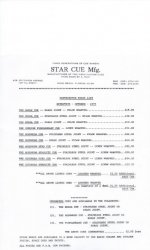Rich cues
I've owned several Rich Qs and they played nicely. Sold them. I still have three cues that may be Abe Rich cues. One I'm pretty sure of, the others not so much. You can see them in the Cue Gallery at
http://sites.google.com/site/donnylutzpool/
I'd appreciate your opinion, if you have time to take a peek!
Just want to keep the flame alive and straighten out some misunderstandings.
Issy "The Professor" made cues under the names New York Billiard Table Company and Bowery Billiards. Fred Astaire was among his celebrity customers.
His son, Saul, began on the Bowery but moved to Long Island. Although the Blue Book and other sources list the company, Rich Cue (Rich Q), as operating in Freeport, I have not been able to confirm that. The company was in Valley Stream near the Queens border in the Sixties. It was sold to Ike Algaze and later Imperial.
Abe and his brother Morris were survivors of the Kovno Ghetto and Dachau. After the war Abe went to Israel and Morris came to the US, where he established Richwood Turning in Miami. Abe joined him in the late Fifties.
Abe went north to "apprentice" with his nephew Saul for a number of years. Impressed by what he perceived as the profitability of the concern post The Hustler, he convinced Morris to let him use part of the Miami shop to make Florida cues.
When the brothers fell out, Morris' son Howard assisted his uncle in moving to a shop in the now fashionable South Beach section of Miami Beach, where he continued until his death to make Star cues.
Purchasing and collecting Rich family cues, as I do, can be quite tricky. The "mass production" Rich products come in considerable variety, with some models achieving Level 5 intricacy. Rich cues were often labeled or identified with stickers, "Rich Q" logos on the forearm or butt or within a window. Some models have -RICH-on the butt cap.
Abe tended to make simple cues without points, many resembling the cues he had made in New York, particularly in their use of plastics and colorful wraps. These designs recall similar contemporary trends from Frank Paradise, Eugene Balner (Palmer), and Doc Fry. Some of his cues also incorporated windows, but usually not in tandem with colored plastics and wraps. White Cortland linen is used instead. He also made Titlelist conversions from time to time. What generally distinguishes his work is the use of exotic woods, of which he kept a great supply at his alleyway shop at 428 Jefferson Avenue. Abe did not sign or label his cues with the exception of the Miami era, when there was a Florida Cue label.
Many cues offered on eBay as Abe Rich cues are their Long Island cousins. Original Florida and Star cues from remaining inventory are sometimes sold by Abe's nephew, Howard Rich. Blue Book values do not generally distinguish between the two.
Issy Rich cues? I've never seen a picture of one, let alone heard of one on sale.
I've owned several Rich Qs and they played nicely. Sold them. I still have three cues that may be Abe Rich cues. One I'm pretty sure of, the others not so much. You can see them in the Cue Gallery at
http://sites.google.com/site/donnylutzpool/
I'd appreciate your opinion, if you have time to take a peek!
